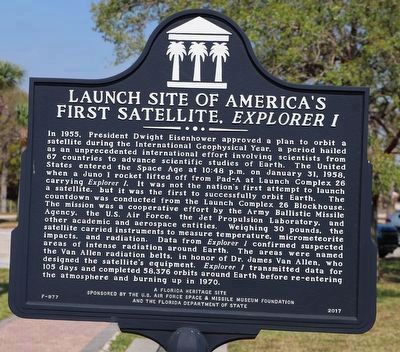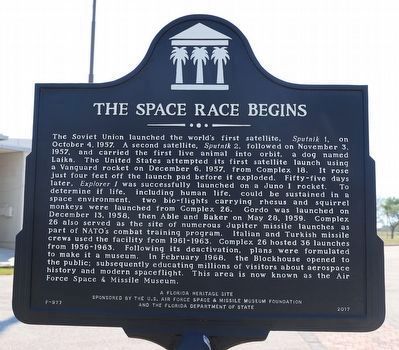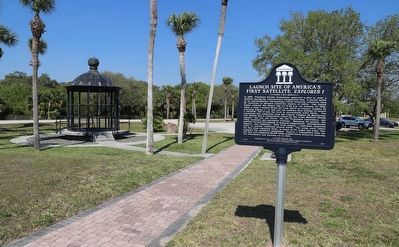Cape Canaveral in Brevard County, Florida — The American South (South Atlantic)
Launch Site of America's First Satellite, Explorer I / The Space Race Begins
Inscription.
(side 1)
In 1955. President Dwight Eisenhower approved a plan to orbit a satellite during the International Geophysical Year, a period hailed as an unprecedented international effort involving scientists from 67 countries to advance scientific studies of Earth. The United States entered the Space Age at 10:48 p.m. on January 31, 1958. when a Juno 1 rocket lifted off from Pad-A at Launch Complex 26 carrying Explorer I. It was not the nation's first attempt to launch a satellite, but it was the first to successfully orbit Earth. The countdown was conducted from the Launch Complex 26 Blockhouse. The mission was a cooperative effort by the Army Ballistic Missile Agency, the U.S. Air Force, the Jet Propulsion Laboratory, and other academic and aerospace entities. Weighing 30 pounds, the satellite carried instruments to measure temperature, micrometeorite impacts, and radiation. Data from Explorer I confirmed suspected areas of intense radiation around Earth. The areas were named the Van Allen radiation belts, in honor of Dr. James Van Allen, who designed the satellite's equipment. Explorer I transmitted data for 105 days and completed 58,376 orbits around Earth before re-entering the atmosphere and burning up in 1970.
(side 2)
The Soviet Union launched the world's first satellite, Sputnik 1, on October 4, 1957. A second satellite, Sputnik 2, followed on November 3, 1957, and carried the first live animal into orbit, a dog named Laika. The United States attempted its first satellite launch using a Vanguard rocket on December 6, 1957, from Complex 18. It rose just four feet off the launch pad before it exploded. Fifty-five days later, Explorer I was successfully launched on a Juno 1 rocket. To determine if life, including human life, could be sustained in a space environment, two bio-flights carrying rhesus and squirrel monkeys were launched from Complex 26. Gordo was launched on December 13, 1958, then Able and Baker on May 28, 1959. Complex 26 also served as the site of numerous Jupiter missile launches as part of NATO's combat training program. Italian and Turkish missile crews used the facility from 1961-1963. Complex 26 hosted 36 launches from 1956-1963. Following its deactivation, plans were formulated to make it a museum. In February 1968, the Blockhouse opened to the public; subsequently educating millions of visitors about aerospace history and modern spaceflight. This area is now known as the Air Force Space & Missile Museum.
Erected 2017 by U.S. Air Force Space & Missile Museum Foundation and the Florida Department of State. (Marker Number F-977.)
Topics. This historical marker is listed in these topic lists: Air & Space • Exploration • Science & Medicine • War, Cold. A significant historical year for this entry is 1955.
Location. 28° 26.679′ N, 80° 34.323′ W. Marker is in Cape Canaveral, Florida, in Brevard County. Marker is on Museum Circle south of Lighthouse Road, on the left when traveling south. Touch for map. Marker is at or near this postal address: 191 Museum Cir, Cape Canaveral FL 32920, United States of America. Touch for directions.
Other nearby markers. At least 8 other markers are within walking distance of this marker. Cape Canaveral Air Force Station (a few steps from this marker); First United States Space Launch (a few steps from this marker); Launch Complex 26 (within shouting distance of this marker); a different marker also named Launch Complex 26 (within shouting distance of this marker); a different marker also named Launch Complex 26 (within shouting distance of this marker); Explorer I (within shouting distance of this marker); a different marker also named Launch Complex 26 (within shouting distance of this marker); Juno II (within shouting distance of this marker). Touch for a list and map of all markers in Cape Canaveral.
Also see . . .
Cape Canaveral Space Force Museum. (Submitted on March 5, 2023.)
Additional keywords. Launch Site of America's First Satellite, Explorer I / The Space Race Begins
Credits. This page was last revised on March 5, 2023. It was originally submitted on March 5, 2023, by Dave W of Co, Colorado. This page has been viewed 107 times since then and 17 times this year. Photos: 1, 2, 3. submitted on March 5, 2023, by Dave W of Co, Colorado. • Bernard Fisher was the editor who published this page.


